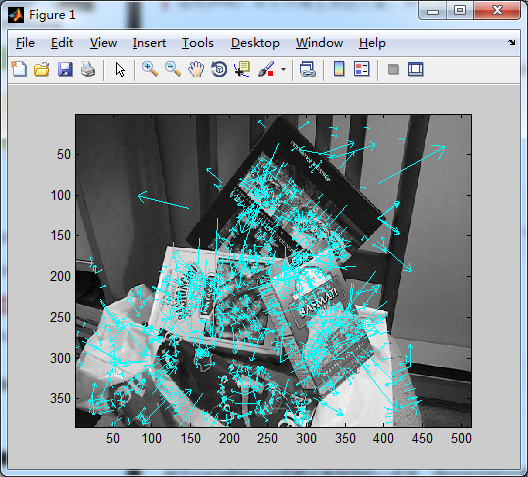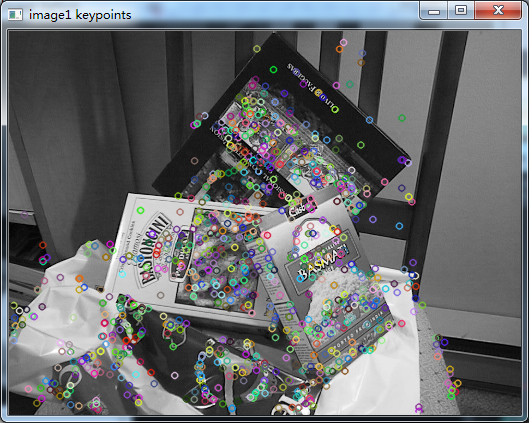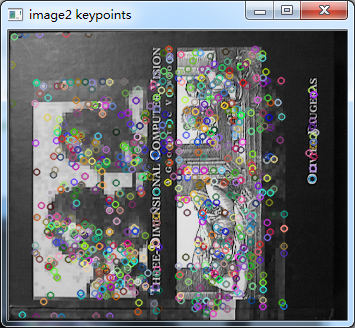影象演算法之三:特徵提取運算元之SIFT
SIFT(Scale-invariant feature transform)是一種檢測區域性特徵的演算法,該演算法通過求一幅圖中的特徵點(interest points,or corner points)及其有關scale 和 orientation 的描述子得到特徵並進行影象特徵點匹配,獲得了良好效果,詳細解析如下:
1、演算法描述
SIFT特徵不只具有尺度不變性,即使改變旋轉角度,影象亮度或拍攝視角,仍然能夠得到好的檢測效果。整個演算法分為以下幾個部分:
(1)構造尺度空間:DoG尺度空間
(2)檢測DoG尺度空間極值點
(3)去除不好的特徵點
(4)給特徵點賦值一個128維的方向引數。每個關鍵點都包含三個資訊:位置、尺度和方向。
(5)關鍵點描述子的生成:
首先將座標軸旋轉為關鍵點的方向,以確保旋轉不變性。以關鍵點為中心取8×8的視窗。
(6)最後進行特徵匹配。當兩幅影象的SIFT特徵向量(128維)生成後,採用關鍵點特徵向量的歐式聚類來作為相似性判定度量。
取影象1中的某個關鍵點,並找出其與影象2中歐式距離最近的前兩個關鍵點,在這兩個關鍵點中,如果最近的距離除以次近的距離少於某個比例閾值,則接受這一對匹配點。降低這個比例閾值,SIFT匹配點數目會減少,但更加穩定。
2、演算法實現:
(一) SIFT的Matlab程式碼實現:
% [image, descriptors, locs] = sift(imageFile)
%
% This function reads an image and returns its SIFT keypoints.
% Input parameters:
% imageFile: the file name for the image.
%
% Returned:
% image: the image array in double format
% descriptors: a K-by 使用方法:
1.尋找影象中的sift特徵:
[image,descrips,locs] = sift('scene.pgm');
showkeys(image,locs);
scene.pgm

book.pgm
2、對兩幅圖中的sift特徵進行匹配
match(‘scene.pgm’,’book.pgm’);
由於scene和book兩幅圖中有相同的一本書,但是方向和尺度都不同,從匹配結果可以看出去sift特徵匹配檢測效果非常好滴!
(二)SIFT的Python實現:
import cv2
import numpy as np
import pdb
pdb.set_trace()#turn on the pdb prompt
#read image
img = cv2.imread('E:\OpenCV\Picture\sky.jpg',cv2.IMREAD_COLOR)
gray = cv2.cvtColor(img,cv2.COLOR_BGR2GRAY)
cv2.imshow('origin',img);
#SIFT
detector = cv2.SIFT() #呼叫SIFT特徵描述子
keypoints = detector.detect(gray,None)#檢測興趣點
img = cv2.drawKeypoints(gray,keypoints)#畫出興趣點
#img = cv2.drawKeypoints(gray,keypoints,flags = cv2.DRAW_MATCHES_FLAGS_DRAW_RICH_KEYPOINTS)
cv2.imshow('test',img);
cv2.waitKey(0)
cv2.destroyAllWindows()測試:
實驗結果:
(三)SIFT的OpenCV實現
#include <opencv2/opencv.hpp>
#include <opencv2/core/core.hpp>
#include <opencv2/imgproc/imgproc.hpp>
#include <opencv2/highgui/highgui.hpp>
#include <iostream>
#include <opencv2/features2d/features2d.hpp>
#include <opencv2/legacy/legacy.hpp>
#include <opencv2/nonfree/nonfree.hpp>
#include <vector>
using namespace std;
using namespace cv;
int main(void)
{
cout << "當前使用的OpenCV版本:" << CV_VERSION << endl;
Mat image = imread("scene.pgm");
Mat image2 = imread("book.pgm");
if (image.empty())
{
fprintf(stderr, "Cannot load image %s \n", "scene.pgm");
return -1;
}
if (image2.empty())
{
fprintf(stderr, "Cannot load image %s \n", "book.pgm");
return -1;
}
//顯示影象
imshow("image before", image);
waitKey(10);
imshow("image2 before", image2);
waitKey(10);
//sift特徵點檢測
SiftFeatureDetector siftdtc;
vector<KeyPoint> kp1, kp2;
siftdtc.detect(image, kp1);
Mat outimg1;
drawKeypoints(image, kp1, outimg1);
imshow("image1 keypoints", outimg1);
siftdtc.detect(image2, kp2);
Mat outimg2;
drawKeypoints(image2, kp2, outimg2);
imshow("image2 keypoints", outimg2);
//生成描述子
SiftDescriptorExtractor ext;
Mat descp1, descp2;
BruteForceMatcher<L2<float>> matcher;
vector<DMatch> matches;
Mat img_matches;
ext.compute(image, kp1, descp1);
ext.compute(image2, kp2, descp2);
imshow("desc", descp1);
waitKey(10);
//cout << endl << descp1 << endl;
matcher.match(descp1, descp2, matches);
drawMatches(image, kp1, image2, kp2, matches, img_matches);
imshow("matches", img_matches);
waitKey(10);
//namedWindow("My Image");
//imshow("My Image",image);
//waitKey(0);
//Mat result,image2,image3;
//result = image;
//image2 = result;
//result.copyTo(image3);
//flip(image, result, 1);//正數水平翻轉,0表示垂直翻轉,負數表示既有水平也有垂直翻轉
//namedWindow("Output window");
//imshow("Output window", result);
//namedWindow("1");
//imshow("1", image2);
//namedWindow("2");
//imshow("2", image3);
waitKey(0);
return 0;
}




